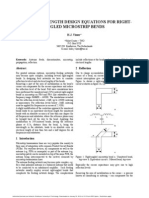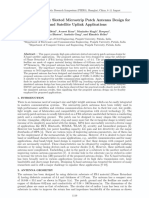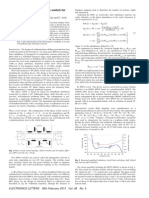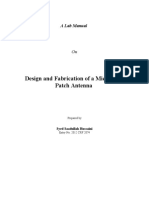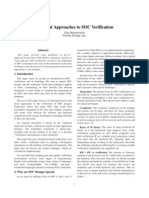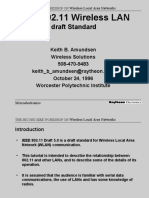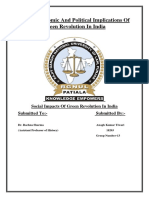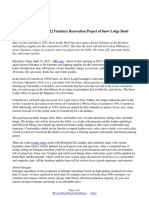X Band Oscillator
X Band Oscillator
Uploaded by
HarshaCopyright:
Available Formats
X Band Oscillator
X Band Oscillator
Uploaded by
HarshaCopyright
Available Formats
Share this document
Did you find this document useful?
Is this content inappropriate?
Copyright:
Available Formats
X Band Oscillator
X Band Oscillator
Uploaded by
HarshaCopyright:
Available Formats
International Conference on Network Universities and e-Learning. 8-9 May 2003. Valencia. Spain. http://www.hsh.
no/menu/
X-BAND MICROWAVE GUNN OSCILLATOR FOR EDUCATIONAL PURPOSES
J.M. Zamanillo*, C. Perez-Vega*, J. Saiz-Ipia and M.A. Solano
ETSII y Telecomunicacin Communications Engineering Department (DICOM) Universidad de Cantabria Av. de los Castros s/n. 39005, Santander, Spain e-mail: jose.zamanillo@unican.es * Microwaves Group Electromagnetism Group
Abstract. A low cost, high performance Gunn X Band oscillator for educational and research purposes has been developed. The cavity has been manufactured on standard waveguide WR90, with UBR100 flange, in order to make it compatible with the rest of waveguide circuitry available in a basic microwave laboratory. The ability to sweep the whole X Band (812 GHz) with constant output power and low phase noise, added to its low cost makes this oscillator an interesting tool for users at any level.
INTRODUCTION
Since the end of the1940s, solidstate devices have replaced tubes in most microwave amplifier and oscillator applications. This class of devices are preferred because their performance and low cost. In the 1960s and 1970s, avalanche and Gunn diodes were extensively used for the generation of microwave power [1-4] and more recently, junction and field-effect transistors have been increasingly used in microwave amplifiers and oscillators. GaAs FETs, and Heterojunction devices have replaced other solid-state devices in many microwave applications; however Gunn and IMPATT diodes are still commonly used at frequencies up to Ka band frequencies (26-40 GHz) and beyond. Given the usually limited resources of universities to endow the basic instrumentation required in educational microwave laboratories, a low cost, high performance Gunn X Band oscillator for educational and research purposes has been developed. The cavity has been manufactured on standard waveguide WR90, with UBR100 flange, in order to make it compatible with the rest of waveguide circuitry available in a basic microwave laboratory. The oscillator may also be used as a microwave source in a wide type of experiments. For these reasons, and taking into account the fragility of Gunn diodes regarding their biasing [5], we have designed an external protection circuit for the device. This robust circuit allows to bias the Gunn diode in a wide range of conditions, so that if the user inverts the biasing polarities or exceeds the maximum working voltage, the Gunn diode will not be damaged.
International Conference on Network Universities and e-Learning. 8-9 May 2003. Valencia. Spain. http://www.hsh.no/menu/
2 GUNN OSCILLATOR Gunn oscillator properties depend on the internal negative resistance due to carrier motion in the semiconductor at high electric fields. When the Gunn diode is biased above the critical threshold field, a negative dielectric relaxation time is exhibited, which results in amplification of any carrier concentration fluctuations, causing a deviation from space-charge neutrality. The resultant domain drifts toward the anode and is extinguished, and a new domain is formed at the cathode. The current through the device consists of a series of narrow spikes with a period equal to the transit time of the domain. When, in a given period of time an RF voltage is superimposed to DC bias, the terminal voltage can be below that of both the threshold voltage and the domain-sustaining voltage. The frequency of oscillation is determined by the resonant circuit, including the impedance of the device. Experimental results and computer simulation [4-7] have shown that the device can be tuned over more than an octave bandwidth by an external cavity. A Gunn diode type MA49156 was chosen for this purpose, because of its availability, good performance and low cost [8]. The bias voltage is applied to the cavity interior via a BNC connector directly attached to the external part, as shown in Figure 3a. Inside the resonant cavity, and in order to optimize its operation, the oscillator includes a sliding short circuit, an iris which acts as a filter, and tuning screws which act as reactive elements, as shown in Figure 1(a). It can also be appreciated in the figure that a threaded drum machined in plastic is included in order to move the short circuit, so the oscillating frequency can be accurately varied. Figure 1(b) shows a photograph of the oscillator, completely mounted and ready for use. To assess the correct operation of the diode inside the resonant cavity, three types of measurements have been performed: output power, frequency spectrum and phase noise of the oscillator. Previously, the matching of the cavity-diode assembly is verified by measuring the scattering parameters of the oscillator without biasing the diode. The matching was found better that 20 dB in the whole band.
Female BNC Biasing Connector Insulating Case M5
Pressure-Adjustable Spring Holes used by two tuning screws
Movable Shortcut
Vertical IRIS Detail of the diode holder with the pressure spring
(a) BNC connector
Detail of female
International Conference on Network Universities and e-Learning. 8-9 May 2003. Valencia. Spain. http://www.hsh.no/menu/
(b)
Vertical IRISES
Detail of the movable Shortcut
Micrometric screw
(c)
Figure 1: (a) Transversal view. (b) Top view. (b) Photograph of the Oscillator.
To assess the correct operation of the diode inside the resonant cavity, three types of measurements have been performed: output power, frequency spectrum, and phase noise of the oscillator. Previously, the matching of the cavity-diode assembly is verified by measuring the scattering parameters of the oscillator without biasing the diode. The matching was found better that 20 dB in the whole band. Figure 2(a) it shows the mechanical tuning characteristics of the Gunn oscillator at in the whole X band. This measure has been performed during the characterization of one of the ten devices manufactured for our RF and microwave laboratory. Figure 2(b) shows the spectrum of the oscillator at 9.98 GHz As can be observed in the figure, the power exceeds 1.5 mW, which is sufficient f most of the laboratory experiments. Also, it can be appreciated there are no in-band or spurious, except one, 55 dB below the output power level at the oscillating frequency.
International Conference on Network Universities and e-Learning. 8-9 May 2003. Valencia. Spain. http://www.hsh.no/menu/
12.5 12 11.5
Frequency (GHz)
11
10.5 10 9.5 9 8.5 8 7.5 5 10 15 20 25 30 35
(a)
Short Circuit position L (mm)
(b)
Figure 2: (a) Mechanical tuning characteristics of the Gunn oscillator. (b) Frequency response @ 9.98 GHz.
In Figure 3 the SSB (single side band) phase noise of the oscillator measured at 10 GHz is shown.
International Conference on Network Universities and e-Learning. 8-9 May 2003. Valencia. Spain. http://www.hsh.no/menu/
Figure 3:
Phase noise plot of the Gunn oscillator @ 9.98 GHz.
PROTECTION CIRCUIT The diagram for the external protection circuit is shown in figure 4.
1 220 V1 D1N4007
VIN
LM317
ADJ
VOUT
R1
R2
220 5k
C2 10u
LED 1 Green
LED 2 Red
POT 1
0
Figure 4: Diagram of the protection circuit.
This circuit allows the biasing of the Gunn diode in a wide range of conditions. If the biasing polarity is reversed, the power diode D1N4007 does not conduct and the output voltage is zero. The programmable linear regulator LM317 is set to the best bias voltage (14V) for the Gunn diode, by varying the value of the potentiometer POT1. If the input bias range exceeds the maximum operation voltage of the Gunn diode, the linear regulator fixes the output voltage at 14 volts (or the maximum
International Conference on Network Universities and e-Learning. 8-9 May 2003. Valencia. Spain. http://www.hsh.no/menu/
voltage set by POT1). Even if the DC supply voltage is increased to up to 40V, the maximum permissible voltage at the input of the LM317, the Gunn diode will not be damaged. 4 CONCLUSIONS
A very low-cost and good performance X-Band Gunn cavity oscillator for use with waveguide WR90 has been developed and tested. This oscillator is capable to sweep all the X-Band (8-12 GHz) with constant output power and low phase noise. Additionally, an external protection circuitry has been designed, to protect the oscillator against polarity inversion or excess voltage when biasing the Gunn diode. Future lines of work contemplate the extension of this cavity for higher power diodes. REFERENCES [1] S. Mitsui and A. Kondo. "CW Gunn Diodes in Composite Structure." 1969 G -MTT International Microwave Symposium Digest of Technical Papers 69.1 (1969 [MWSYM]): pp.191-195. [2] S. Hashiguchi and T. Okoshi. "Determination of Equivalent Circuit Parameters Describing Noise from a Gunn Oscillator." 1971 Transactions on Microwave Theory and Techniques 19.8 (Aug. 1971 [T-MTT]): pp. 686-691. [3] J.F. White. "Simplified Theory for Post Coupling Gunn Diodes to Waveguide." 1972 Transactions on Microwave Theory and Techniques 20.6 (Jun. 1972 [T-MTT]): 372-378. [4] Y. Ito, H. Komizo, T. Meguro, Y. Daido and I. Umebu. "Experimental and Computer Simulation Analysis of a Gunn Diode.1971 G-MTT International Microwave Symposium Digest of Technical Papers 71.1 (1971 [MWSYM]): pp.152-153. [5] Y. Wang and K.J. Gu. "Modeling, Analysis and Optimization of GUNN Diode VCO." 1990 MTT-S International Microwave Symposium Digest 90.1 (1990 Vol. I [MWSYM]): pp.327330. [6] M.A. Solano, J. Saiz-Ipia, J.M. Zamanillo and C. Perez-Vega. X-Band Gunn Diode Oscillator for a Multiplefrequency Continuous Wave Radar for Educational Purposes. IEEE Transactions on Education. Volume 45, No.4, pp 316,322 Nov.2002. [7] D. Christiansen Electronic Engineers Handbook. McGraw-Hill Fourth Edition 1996. [8] J.S.Ipia, J.M. Zamanillo, J.C. Gonzalez, M. A. Solano, A. Vegas, A. Prieto, C. Prez-Vega. Osciladores a Diodo Gunn para Docencia en Banda X, Unin Cientfica Internacional de Radio URSI, XV Simposium Nacional, Actas, pp 163-164, Zaragoza, Septiembre de 2000.
You might also like
- KOR-1B4H ManualDocument33 pagesKOR-1B4H ManualGrigore ManNo ratings yet
- Design of Compact Antenna With Modified Ground Plane For Ultra Wide Band CommunicationDocument4 pagesDesign of Compact Antenna With Modified Ground Plane For Ultra Wide Band CommunicationInternational Journal of Application or Innovation in Engineering & ManagementNo ratings yet
- Ijecet: International Journal of Electronics and Communication Engineering & Technology (Ijecet)Document5 pagesIjecet: International Journal of Electronics and Communication Engineering & Technology (Ijecet)IAEME PublicationNo ratings yet
- Novel Planar Wideband Omni-Directional Quasi Log-Periodic AntennaDocument4 pagesNovel Planar Wideband Omni-Directional Quasi Log-Periodic Antennamano012No ratings yet
- Experiment 1 - Study of Microwave ComponentsDocument11 pagesExperiment 1 - Study of Microwave ComponentsSai Saswat Sahu100% (1)
- A Reconfigurable Wideband and Multiband Antenna Using Dual-Patch Elements For Compact Wireless DevicesDocument8 pagesA Reconfigurable Wideband and Multiband Antenna Using Dual-Patch Elements For Compact Wireless DevicesPECMURUGANNo ratings yet
- U-Slot Loaded Square Monopole Microstrip Antenna For Wide Band OperationDocument5 pagesU-Slot Loaded Square Monopole Microstrip Antenna For Wide Band OperationIJRASETPublicationsNo ratings yet
- Millimeter-Wave Dual-Band Microstrip Patch Antennas Using Multilayer Gaas TechnologyDocument4 pagesMillimeter-Wave Dual-Band Microstrip Patch Antennas Using Multilayer Gaas TechnologyShivanandKalmaniNo ratings yet
- Masaki 1994Document6 pagesMasaki 1994Tiago GonçalvesNo ratings yet
- Performance Analysis of Microstrip Patch Antenna Using Coaxial Probe Feed TechniqueDocument3 pagesPerformance Analysis of Microstrip Patch Antenna Using Coaxial Probe Feed TechniqueInternational Jpurnal Of Technical Research And Applications100% (1)
- Bend in Microstrip LinesDocument6 pagesBend in Microstrip LinesShilpa MohanNo ratings yet
- Analysis of Substrate Integrated Waveguide AntennasDocument6 pagesAnalysis of Substrate Integrated Waveguide Antennasmichael.33326No ratings yet
- Performance Analysis of Microstrip Patch Antenna by Varying Slot Size For UMTS ApplicationDocument5 pagesPerformance Analysis of Microstrip Patch Antenna by Varying Slot Size For UMTS Applicationsiva1427No ratings yet
- V5i3 Ijertv5is030037Document5 pagesV5i3 Ijertv5is030037Ramya RNo ratings yet
- Microwave Practicle ManualDocument25 pagesMicrowave Practicle Manualmubin.pathan765No ratings yet
- Design Analysis of Slotted Diagonal Shape Patch Antenna With Hybrid CouplerDocument6 pagesDesign Analysis of Slotted Diagonal Shape Patch Antenna With Hybrid CouplerIJERDNo ratings yet
- Design of A Low-Loss Series-Fed Microstrip Array AntennaDocument4 pagesDesign of A Low-Loss Series-Fed Microstrip Array AntennamoomoerNo ratings yet
- Experiment 1Document12 pagesExperiment 1Ashish Meena100% (1)
- Defective Ground Structure Microstrip Patch Antenna For ISM, Wi-MAX and C-Band Using U Slotted StructureDocument8 pagesDefective Ground Structure Microstrip Patch Antenna For ISM, Wi-MAX and C-Band Using U Slotted StructureIJAFRCNo ratings yet
- Vivaldi Antenna Intro With Design ProcedureDocument5 pagesVivaldi Antenna Intro With Design ProcedureAbdul Ali KakarNo ratings yet
- 60 GHZDocument9 pages60 GHZjackofmanytradesNo ratings yet
- Planar Rectangular Microstrip Antenna For Dualband OperationDocument4 pagesPlanar Rectangular Microstrip Antenna For Dualband OperationLive To LoveNo ratings yet
- A Low-Profile 2D Passive Phased-Array Antenna-in-Package For Emerging Millimeter-Wave ApplicationsDocument6 pagesA Low-Profile 2D Passive Phased-Array Antenna-in-Package For Emerging Millimeter-Wave ApplicationsShaik KareemullaNo ratings yet
- Sequential RotationDocument4 pagesSequential RotationindameantimeNo ratings yet
- Connected U-Slots Patch Antenna For WiMAX ApplicationsDocument18 pagesConnected U-Slots Patch Antenna For WiMAX ApplicationsAGUSTIN SEVERINONo ratings yet
- Microstrip Annular Ring Slot Antenna! For Mobile ApplicationsDocument2 pagesMicrostrip Annular Ring Slot Antenna! For Mobile Applicationsmykeenzo5658No ratings yet
- A Simple Frequency Reconfigurable Microstrip Patch Antenna For Wireless CommunicationDocument5 pagesA Simple Frequency Reconfigurable Microstrip Patch Antenna For Wireless CommunicationMes TAREKNo ratings yet
- Efficient 2.45 GHZ Rectenna Design With High Harmonic Rejection For Wireless Power TransmissionDocument4 pagesEfficient 2.45 GHZ Rectenna Design With High Harmonic Rejection For Wireless Power TransmissionEk RishtaaNo ratings yet
- Compact Microstrip Feeding Network For Mobile Base Station AntennaDocument5 pagesCompact Microstrip Feeding Network For Mobile Base Station AntennaInnovative Research PublicationsNo ratings yet
- High Gain Substrate Slütted Micrüstrip Patch Antenna Design Für X-Band Satellite Uplink ApplicatiünsDocument5 pagesHigh Gain Substrate Slütted Micrüstrip Patch Antenna Design Für X-Band Satellite Uplink ApplicatiünsKarthik DevarajanNo ratings yet
- The Effect of Dielectric Loss Tangent On Radiation Characteristics of Co-Axial Feed Rectangular Patch AntennaDocument4 pagesThe Effect of Dielectric Loss Tangent On Radiation Characteristics of Co-Axial Feed Rectangular Patch AntennaInnovative Research PublicationsNo ratings yet
- Design of Compact Printed Antenna For Umts & Wimax ApplicationsDocument4 pagesDesign of Compact Printed Antenna For Umts & Wimax ApplicationsIJERDNo ratings yet
- A Miniaturised Monopole Wideband Antenna WithDocument7 pagesA Miniaturised Monopole Wideband Antenna WithIndrajit GuptaNo ratings yet
- Frequency Reconfigurable U-Slot Microstrip Patch AntennaDocument3 pagesFrequency Reconfigurable U-Slot Microstrip Patch AntennaGAUTI2212No ratings yet
- Ijaret: ©iaemeDocument5 pagesIjaret: ©iaemeIAEME PublicationNo ratings yet
- Vibration Study - Electromontaj - 400kV Tantareni-Kozlodui - ACSR 160 - 95-Rev. ADocument14 pagesVibration Study - Electromontaj - 400kV Tantareni-Kozlodui - ACSR 160 - 95-Rev. ALiciu CiprianNo ratings yet
- 2P8 0911 PDFDocument3 pages2P8 0911 PDFJohn C. YoungNo ratings yet
- CPW-Fed Capacitive Coupled Slot Antenna: Nternational Ournal of Nnovative Esearch in Omputer and Ommunication NgineeringDocument6 pagesCPW-Fed Capacitive Coupled Slot Antenna: Nternational Ournal of Nnovative Esearch in Omputer and Ommunication NgineeringNag ChallaNo ratings yet
- Design and Simulation Based Studies of A Dual Band Antenna For Wlan/Wimax ApplicationDocument5 pagesDesign and Simulation Based Studies of A Dual Band Antenna For Wlan/Wimax ApplicationIjarcet JournalNo ratings yet
- 1 5002033 PDFDocument9 pages1 5002033 PDFDmk ChaitanyaNo ratings yet
- Broadband Ka-Band 90° Phase Switch For Radio Astronomy: E. Villa, L. de La Fuente, J. Cagigas, B. Aja and E. ArtalDocument2 pagesBroadband Ka-Band 90° Phase Switch For Radio Astronomy: E. Villa, L. de La Fuente, J. Cagigas, B. Aja and E. ArtalNavin Andrew PrinceNo ratings yet
- 5 - Semi-Circular Stubs UWB Monopole Antenna With Tunable Dual Band-Notch CharacteristicsDocument9 pages5 - Semi-Circular Stubs UWB Monopole Antenna With Tunable Dual Band-Notch Characteristicsel_be7eryNo ratings yet
- Design and Fabrication of A Microstrip Patch AntennaDocument5 pagesDesign and Fabrication of A Microstrip Patch AntennaAjinkya Dnyaneshwar DhumaleNo ratings yet
- A Differential Active Patch Patch - Ieee - Let - 2003 - MWCLDocument3 pagesA Differential Active Patch Patch - Ieee - Let - 2003 - MWCLSaikat Ch BakshiNo ratings yet
- Controllable Band-Notched UWB Printed Monopole AntennaDocument5 pagesControllable Band-Notched UWB Printed Monopole AntennaInnovative Research PublicationsNo ratings yet
- A New Miniaturized Patch Antenna For WirelessDocument5 pagesA New Miniaturized Patch Antenna For WirelessrocinguyNo ratings yet
- Butterfly Design Mesh Antenna of Optical RectennaDocument9 pagesButterfly Design Mesh Antenna of Optical Rectennaservice infoNo ratings yet
- Analysis of Gunn Diode Loaded Circular Microstrip Antenna: Isha Singh, Ajay Kumar Yadav, Alka VermaDocument3 pagesAnalysis of Gunn Diode Loaded Circular Microstrip Antenna: Isha Singh, Ajay Kumar Yadav, Alka VermaerpublicationNo ratings yet
- Frequency Reconfigurable Triple Band-Notched Ultra-Wideband Antenna With Compact SizeDocument11 pagesFrequency Reconfigurable Triple Band-Notched Ultra-Wideband Antenna With Compact SizenikitaNo ratings yet
- Paper Rectena (ENG)Document4 pagesPaper Rectena (ENG)Onang NugrohoNo ratings yet
- 40GHz Wide-Locking-Range Regenerative Frequency Divider and Low-Phase-Noise Balanced VCO in 0p18μm CMOSDocument3 pages40GHz Wide-Locking-Range Regenerative Frequency Divider and Low-Phase-Noise Balanced VCO in 0p18μm CMOSMohamed Mostafa0% (1)
- Absolute EPR Spin Echo #69A PDFDocument15 pagesAbsolute EPR Spin Echo #69A PDFchaparalNo ratings yet
- Electromagnetic Sensing of Partial Discharge in Air-Insulated Medium Voltage SwitchgearDocument4 pagesElectromagnetic Sensing of Partial Discharge in Air-Insulated Medium Voltage SwitchgearThameemul BuhariNo ratings yet
- 1ap 0221Document2 pages1ap 0221Đỗ ToànNo ratings yet
- Dual-Band Monopole Antenna With Frequency-Tunable Feature For Wimax ApplicationsDocument4 pagesDual-Band Monopole Antenna With Frequency-Tunable Feature For Wimax ApplicationsFirman Nico ChandraNo ratings yet
- III DECE Advanced Communications LabDocument23 pagesIII DECE Advanced Communications LabKethavath Sakrunaik K100% (1)
- Cognetive RedioDocument10 pagesCognetive RedioNIET14No ratings yet
- Microwave Letter Siw May2009 64231Document3 pagesMicrowave Letter Siw May2009 64231Shunmugam ChandrasekaranNo ratings yet
- 21 EffectDocument10 pages21 Effectsebampitako duncanNo ratings yet
- 802 11acDocument29 pages802 11acHarshaNo ratings yet
- Verisity SOCverifyDocument7 pagesVerisity SOCverifysurya75sNo ratings yet
- Mobile CommunicationsDocument49 pagesMobile CommunicationsHarsha100% (1)
- IEEE 802.11 Wireless LAN: Draft StandardDocument23 pagesIEEE 802.11 Wireless LAN: Draft Standardswapankumar62No ratings yet
- Emf NotesDocument79 pagesEmf NotesTaimur Musharraf60% (5)
- Electric Circuits and Electron DevicesDocument62 pagesElectric Circuits and Electron DevicesHarshaNo ratings yet
- Image Segmentation Algorithms: - Otsu (1979) - Fisher (1936)Document13 pagesImage Segmentation Algorithms: - Otsu (1979) - Fisher (1936)HarshaNo ratings yet
- Edge DetectionDocument36 pagesEdge DetectionHarshaNo ratings yet
- Serial Comm in 8051Document21 pagesSerial Comm in 8051HarshaNo ratings yet
- 529 - Microwave Circuit Design by PrashanthDocument38 pages529 - Microwave Circuit Design by PrashanthHarshaNo ratings yet
- Thumb Instruction SetDocument30 pagesThumb Instruction SetHarshaNo ratings yet
- Serial CommunicationDocument48 pagesSerial CommunicationHarshaNo ratings yet
- Real Time Operating SystemsDocument44 pagesReal Time Operating SystemsAnand PatraNo ratings yet
- Final Chapter 6 PDFDocument15 pagesFinal Chapter 6 PDFManoj ReddyNo ratings yet
- Z-Transform - CH 7Document13 pagesZ-Transform - CH 7carmo-netoNo ratings yet
- RESONANCE Equations For PreRmoDocument36 pagesRESONANCE Equations For PreRmoAyush KumarNo ratings yet
- Revision - TACN DUOC - Bu I Ôn 1Document4 pagesRevision - TACN DUOC - Bu I Ôn 1Đức BùiNo ratings yet
- Appendix 5 To Report No. 55809406 (1st Copy) : Page 1 of 6Document6 pagesAppendix 5 To Report No. 55809406 (1st Copy) : Page 1 of 6RaimisNo ratings yet
- Ducati 1098 2007 Parts List WWW - Manualedereparatie.infoDocument116 pagesDucati 1098 2007 Parts List WWW - Manualedereparatie.infodreamopenerNo ratings yet
- Black and Decker Food Steamer Rice Cooker and ManualDocument30 pagesBlack and Decker Food Steamer Rice Cooker and ManualTaranisaNo ratings yet
- EasYgen 3500XT LS 5 PresentationDocument16 pagesEasYgen 3500XT LS 5 PresentationGaurav TaydeNo ratings yet
- 12th Score CardDocument1 page12th Score CardBhavesh AhujaNo ratings yet
- Culinary TourismDocument16 pagesCulinary TourismВалерия НевежинаNo ratings yet
- Level Past Paper Questions - Physics O: TOPIC-16 Magnetism PAPER-1 Multiple ChoiceDocument10 pagesLevel Past Paper Questions - Physics O: TOPIC-16 Magnetism PAPER-1 Multiple Choiceelty TanNo ratings yet
- Acute Glomerulonephritis Poststreptococcal NCLEX ReviewDocument4 pagesAcute Glomerulonephritis Poststreptococcal NCLEX ReviewJhean MeansNo ratings yet
- Alice in WonderlandDocument36 pagesAlice in Wonderlandgabyazcurra92% (12)
- Is 15537 2004Document14 pagesIs 15537 2004Muhammad ImranNo ratings yet
- SCHR Odinger Equation From An Exact Uncertainty PrincipleDocument16 pagesSCHR Odinger Equation From An Exact Uncertainty PrincipleJonNo ratings yet
- Anagh HistoryDocument15 pagesAnagh HistoryParth TiwariNo ratings yet
- Ari AdjiDocument26 pagesAri AdjiIrfan SungkarNo ratings yet
- Operation & Safety Manual: Military Telehandler Personnel Work PlatformDocument40 pagesOperation & Safety Manual: Military Telehandler Personnel Work PlatformBart JohnNo ratings yet
- S SeriesDocument284 pagesS SeriestatoddoNo ratings yet
- Lesson 1: Boyle's LawDocument16 pagesLesson 1: Boyle's LawKen ArellanoNo ratings yet
- Ecotherm Brochure Image EnglishDocument19 pagesEcotherm Brochure Image Englishprag314No ratings yet
- CFD Modeling of Heat Transfer, Boiling and Condensation: Nufoam & NumpoolDocument20 pagesCFD Modeling of Heat Transfer, Boiling and Condensation: Nufoam & NumpoolSamarul MeuNo ratings yet
- SAIC-LT-2007 LeaK Testing-Vacuum BoxDocument3 pagesSAIC-LT-2007 LeaK Testing-Vacuum BoxKirubhakarPooranamNo ratings yet
- Fuleague Wins Bid For 2022 Furniture Renovation Project of Snow Lodge Hotel Courchevel 1850 FranceDocument4 pagesFuleague Wins Bid For 2022 Furniture Renovation Project of Snow Lodge Hotel Courchevel 1850 FrancePR.comNo ratings yet
- Case Study ChevronDocument1 pageCase Study Chevronmuhammad Devananda100% (1)
- Effect of Operational Parameters On The Removal of Azo 2 Naphthol Dye On Aluminium Electrodes by ElectrocoagulationDocument8 pagesEffect of Operational Parameters On The Removal of Azo 2 Naphthol Dye On Aluminium Electrodes by ElectrocoagulationEko Ariyanto Wong PlembangNo ratings yet
- 2012 KGSP University Information - EnglishDocument333 pages2012 KGSP University Information - EnglishYusuf Boodiman MarzNo ratings yet
- Custom MCQ - 3 by VGDocument10 pagesCustom MCQ - 3 by VGIS WING APNo ratings yet
- VIVLIA ANTALLAKTIKWN 8.7730-7930 SerieDocument26 pagesVIVLIA ANTALLAKTIKWN 8.7730-7930 Serieinfo7879No ratings yet
- Panel Wood LaboratoryDocument4 pagesPanel Wood Laboratorymunawir anazliNo ratings yet










